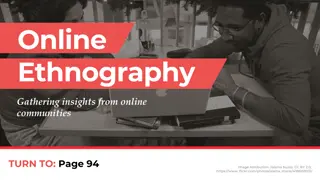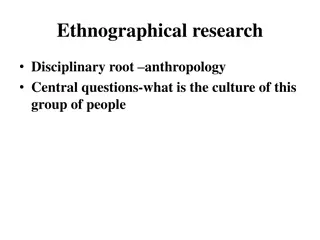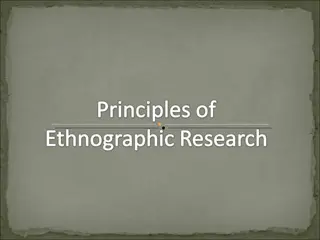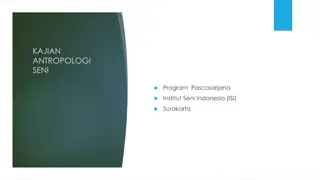Introduction to Ethnography Methods and Applications
This project introduces ethnography and its applications in research. Explore the origins, principles, and writing style of ethnography, along with key research methods such as participant-observation. Learn how ethnographic research can enhance your own projects by understanding people's lives and experiences from within different cultures. Join us to delve into the world of qualitative descriptive research and discover the art of ethnography writing.
Download Presentation

Please find below an Image/Link to download the presentation.
The content on the website is provided AS IS for your information and personal use only. It may not be sold, licensed, or shared on other websites without obtaining consent from the author.If you encounter any issues during the download, it is possible that the publisher has removed the file from their server.
You are allowed to download the files provided on this website for personal or commercial use, subject to the condition that they are used lawfully. All files are the property of their respective owners.
The content on the website is provided AS IS for your information and personal use only. It may not be sold, licensed, or shared on other websites without obtaining consent from the author.
E N D
Presentation Transcript
Introducing Ethnography Ethnographic Encounters Project Dr Lisa Bernasek (with thanks to Dr Heidi Armbruster) l.bernasek@soton.ac.uk
Objectives and overview This session will provide an introduction to ethnographic methods and help you reflect on how these methods can be used within your own research topic. As a result of attending this session you will be able to: Identify the key elements of ethnographic research and writing; Reflect on how ethnographic methods can contribute to your own research project; Plan the main steps in an ethnographic project, considering practical and ethical issues. 2
What is ethnography? Qualitative Descriptive ? ? ? 3
What is ethnography? Origins of ethnography Development of social anthropology early 20th century Long-term fieldwork in other cultures (Bronislaw Malinowski, Argonauts of the Western Pacific, 1922) Now used at home and in variety of disciplines (sociology, education studies, cultural studies) Focus on people s lives and experiences from the inside 4
What is ethnography? Ethnographic principles Qualitative data, mainly collected through participant- observation Based on research in natural settings Small-scale groups/settings/events Extended period of research Sense of discovery and reaching understanding of the setting from the inside - what people do vs. what they say they do 5
What is ethnography? Ethnographic writing Ethnographic texts are highly descriptive: see Clifford Geertz on thick description Explores people s lives and experiences Looks at symbolic meanings, social and cultural structures and practices To learn more: Look for an ethnography in your topic area 6
Ethnographic research methods Multiple methods and sources Participant-Observation Researcher is active participant and first-hand observer Asking questions where possible Ethnographic conversations Exploring questions or issues you don t understand May be recorded but not based on set questions 7
Ethnographic research methods Further methods to explore specific issues/questions: semi-structured interviews focus groups mapping (physical space, kinship or other relationships) Other sources: documents photographs objects of importance in the setting/to the people previous writing on the topic 8
Key points when starting out Go in with research question/topic but remain open to change Contingent nature of ethnographic research much depends on who you meet/where you go Identify key place(s) or group(s) where you can observe and interact over a period of time Being there gives you opportunities to observe and make connections 9
Steps and tips for doing an ethnography 1. Developing a research problem 2. Choosing a group or event(s) to study 3. Getting access 4. Making relationships 5. Collecting data 6. Recording and organising data 7. Analysing data 8. Using different data sources 9. Writing up (Steps adapted from Hammersley, M. & Atkinson, P. (2007) Ethnography: principles in practice. London, UK: Routledge, 2007.) 10
Steps in doing an ethnography 1. Developing a research problem Foreshadowed problems (Malinowski) Go in with general problem or question to explore rather than a specific hypothesis or preconceived idea Be open to change 2. Choosing a group or event(s) to study Small-scale groups Events or practices with research about context 11
Steps in doing an ethnography 3. Getting access Ethics: research must be done openly and with informed consent Key informants or gatekeepers 4. Making relationships Takes time Consider your position in relation to group (insider/outsider) and your social identity (gender, nationality, class ) 12
Steps in doing an ethnography 5. Collecting data Types of data you might gather: Notes from participant observations and informal conversations Interview recordings and transcripts Video recordings and accompanying notes Photographs, maps, ephemera Maps or drawings by research participants Media or online sources Other documents related to the setting Further notes to keep: Analytical notes with rough drafts of analysis Field diaries with personal reflections and reactions 13
Steps in doing an ethnography 5. Collecting data (2) Things to think about in making observations: Context/history of setting Actors/groups/social relationships Space and physical environment Organisational structures and relationships Language used (registers, specific vocabularies, idiomatic expressions) Non-verbal communication Common activities and routines Objects/material world Aims what do people try to accomplish Feelings expressed by participants 14
Steps in doing an ethnography 6. Recording and organising data Devote time to writing notes and organising data Think about chronological accounts as well as thematic accounts Keep careful records of everything you are collecting develop a system and be consistent and disciplined Make back-up copies Notes and transcripts should be anonymised to protect the research participants identities 15
Steps in doing an ethnography 7. Analysing data Part of ongoing data collection how you organise data, making analytical notes Try to describe before you interpret/explain Think about emerging patterns, important themes and folk concepts , analytical categories (gender, kinship, class) Interrogate your data for further evidence of your analysis (and contrasting evidence) 16
Steps in doing an ethnography 8. Using different data sources Observing at different times Speaking to different people Collecting information in different ways Other information about the setting Triangulating data 17
Steps in doing an ethnography 9. Writing up Takes time and numerous drafts Part of ongoing process of analysis Relation to themes and concepts in the literature Plus one step: sharing results with research participants 18
Ethics Principles of ethical ethnographic research: Do no harm Overt research Informed consent Anonymity of participants Health and Safety: think about yourself as well! 19
Reflection Thinking about your own research topic, write down then share with a partner: 1. Your main research question. 2. What setting/group you will use to explore this question. 3. How you would gain access to this setting/group. Do you foresee any difficulties doing this? 4. Any ethical issues raised by this research. Would you be able to obtain informed consent and protect your participants identities? 20
Further resources/references Geertz, C. (1973) 'Thick Description: Toward an Interpretive Theory of Culture', in The Interpretation of Cultures. HarperCollins. pp. 3 30. Hammersley, M. (1992) Introducing Ethnography. Sociology Review. 2 (2), 18 20. Hammersley, M. & Atkinson, P. (2007) Ethnography: principles in practice. London, UK: Routledge, 2007. Graham Gibbs: Ethnography. Part 1 of 2 on Ethnography and Participant Observation: http://www.youtube.com/watch?v=V8doV3P0us4 Graham Gibbs: What to observe in Participant Observation. Part 2 of 2 on Ethnography and Participant Observation: http://www.youtube.com/watch?v=JADIR-J9Ht4 21























